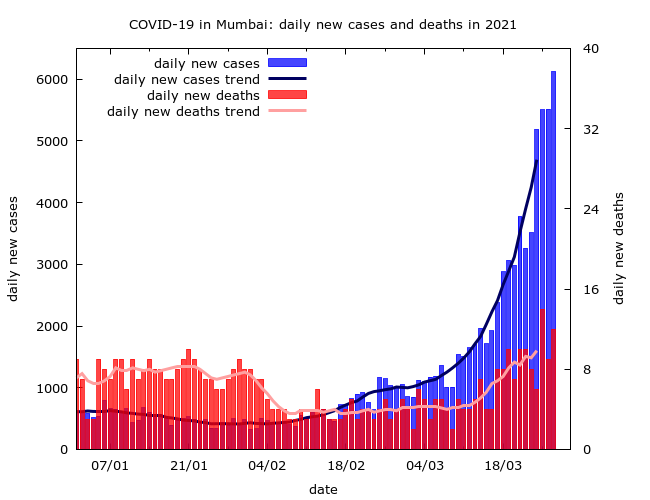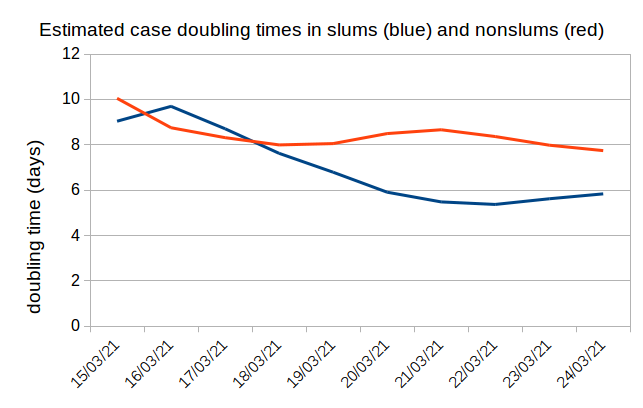
It's hard to discuss COVID-19 in Mumbai without sounding alarmist. Because the situation is alarming. Calculations suggest:
- more people are being infected daily in housing societies than ever before
- transmission in slums could be close to the huge speeds of April-May 2020.
🧵
- more people are being infected daily in housing societies than ever before
- transmission in slums could be close to the huge speeds of April-May 2020.
🧵
In the last week Mumbai has recorded 43K cases. But this figure is useless if we don't know how many infections are missed. I estimate:
43K cases = more than 7 lakh infections. That's >5% of the city. In one week.
Let's see how. [Notes on the numbers at the end.]
43K cases = more than 7 lakh infections. That's >5% of the city. In one week.
Let's see how. [Notes on the numbers at the end.]
In the last week ~15% of tests returned +ve. (About half were rapid - if all had been more sensitive RT-PCR tests, positivity would be closer to 20%.) We know that as test positivity (TPR) rises, detection drops - the fraction of missed infections rises. Let's track back...
TPR and % of infections detected in slums/nonslum areas:
Upto 8/7/20: TPR=24%, ~0.8% in the slums, ~5.9% in housing societies
8/7/20-31/12/20: TPR=10%, ~2.5% in the slums, ~11% in housing societies
Last week: TPR=15%, ??% in the slums, ??% in housing societies
Upto 8/7/20: TPR=24%, ~0.8% in the slums, ~5.9% in housing societies
8/7/20-31/12/20: TPR=10%, ~2.5% in the slums, ~11% in housing societies
Last week: TPR=15%, ??% in the slums, ??% in housing societies
We don't know current detection. But let's be optimistic and suppose it has remained at the levels estimated for later in 2020: ~2.5% in the slums and 11% in housing societies. This would mean currently ~1 lakh daily transmissions: ~60K in the slums, and ~40K in nonslum areas.
These figures are optimistic: they assume that detection hasn't suffered even though TPR is higher.
For context: 40K daily transmissions in housing societies is much more than ever before. 60K daily transmissions in the slums compares to an estimated >1 lakh at first wave peak.
For context: 40K daily transmissions in housing societies is much more than ever before. 60K daily transmissions in the slums compares to an estimated >1 lakh at first wave peak.
So COVID is really raging in the city - both "halves" of it. If it is any comfort, the rate of rise of new cases seems to have slowed recently. (Doubling time has risen.)
BUT, until test positivity starts to fall, it's too early to read much into this.
BUT, until test positivity starts to fall, it's too early to read much into this.
Note 1. Estimates of slum/nonslum cases follow a procedure described in this link. This gives about 22% of current cases from the slums. But the difference in detection would imply around 60% of new infections occurring in the slums.
github.com/muradbanaji/Mu…
github.com/muradbanaji/Mu…
Note 2. Estimates of detection upto early July are based on the first serosurvey. The calculations are here (maths.mdx.ac.uk/research/model…). They accompanied this piece on Mumbai's second surge:
science.thewire.in/health/mumbai-…
science.thewire.in/health/mumbai-…
Note 3. Estimates of detection after 8/7/20 use recorded fatalities + a later slum serosurvey. They assume that ~20% of fatalities were from the slums after July 2020. This is consistent with 75% prior infection in the slums by the year end. (I'll put up a doc on this.)
• • •
Missing some Tweet in this thread? You can try to
force a refresh










